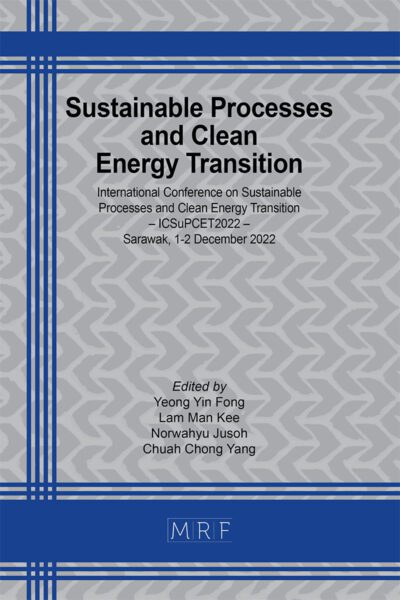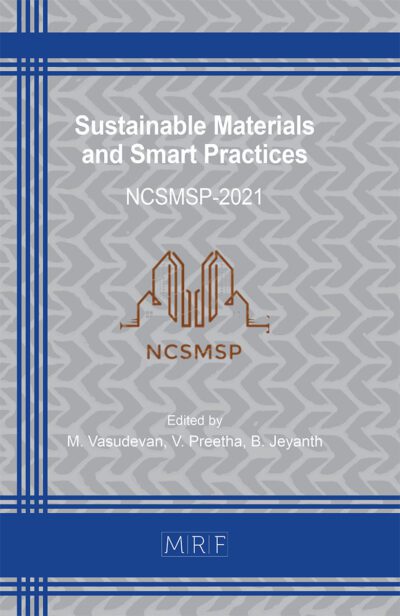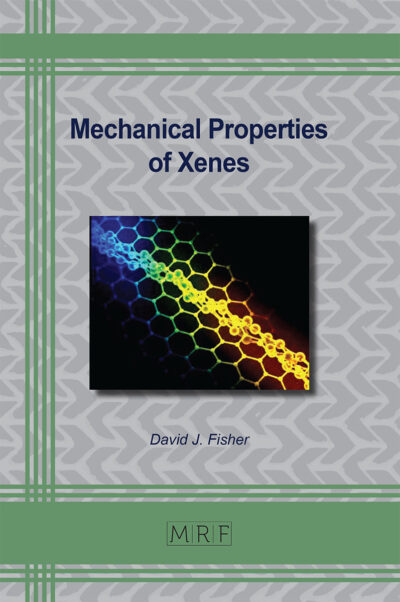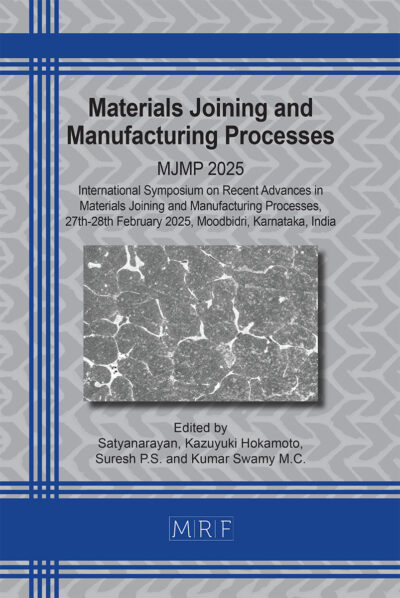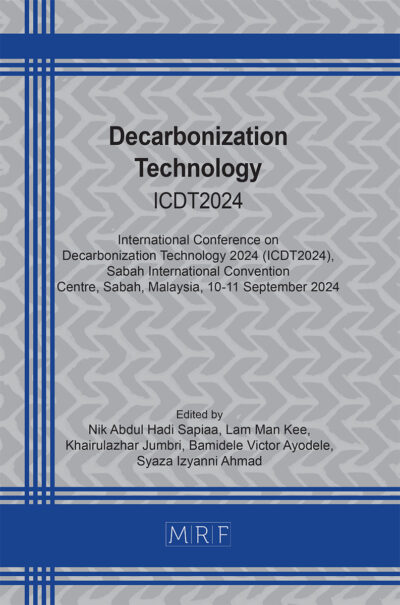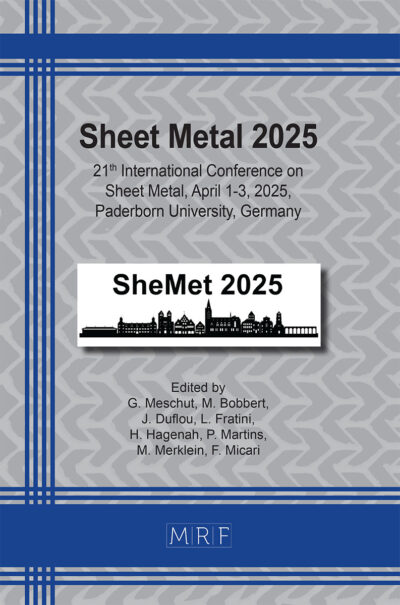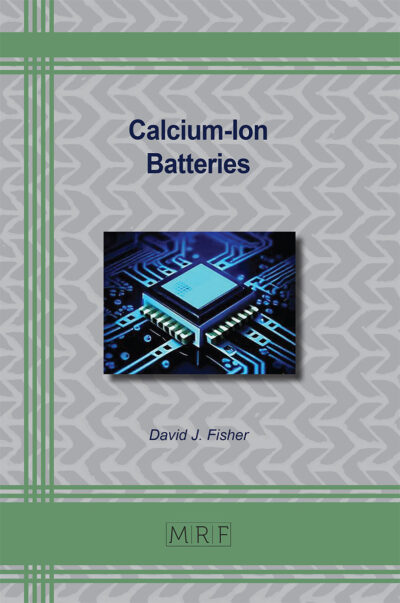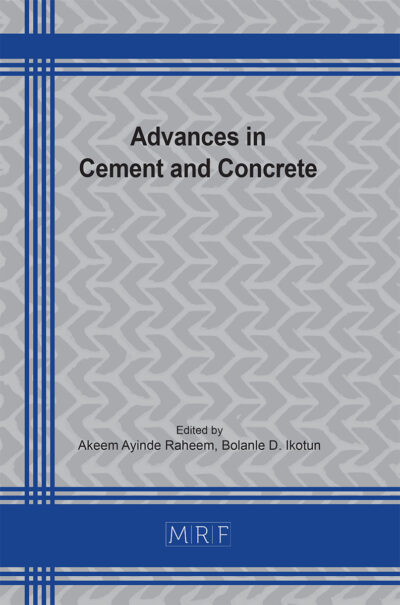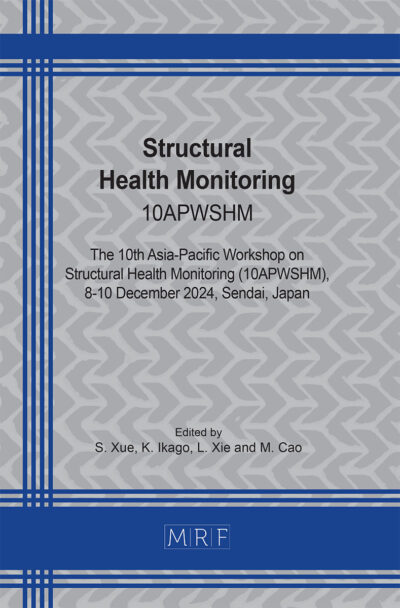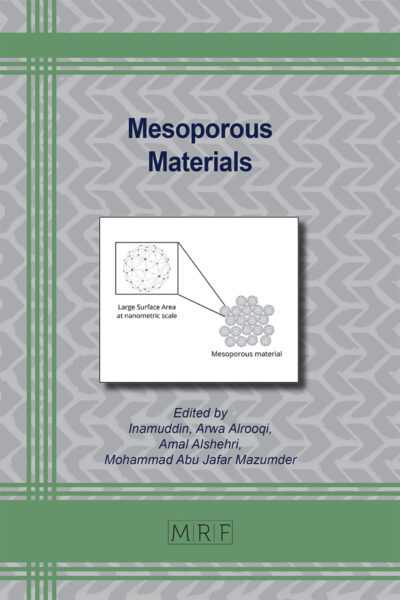Optimization of fly ash-g-polyacrylic acid hydrogel via response surface methodology for improved amine loading capacity
ALI SHAH Syed Farman, RABAT Nurul Ekmi, JOHARI Khairiraihanna, MT GHANI Siti Musliha, ABDUL Sami
Abstract. Amine solvent has shown great sour gases separation capacity from natural gas. This paper studied the optimization of monoethanolamine loading capacity on the fly ash grafted polyacrylic acid hydrogel using response surface methodology. The central composite design was used to determine the effect of three independent variables particularly fly ash as a filler, N, N”-methylene bis acrylamide as a crosslinker, and ammonia peroxide sulphate as an initiator. The optimization study revealed the significance of factors in the following order: cross-linker > fly ash > initiator, with an R² value of 0.99. The fly ash grafted hydrogel achieved a maximum amine loading of up to 1550 wt.% with the addition of 1.1 g of fly ash, 0.07 g of cross-linker, and 0.07 g of initiator. It was investigated that varying the concentration of crosslinker was significantly enhanced the amine loading. Furthermore, SEM and FTIR were performed to analyze the morphology and chemical changes in the optimum fly ash grafted hydrogel. The results depicted that the fly ash grafted hydrogel has porous structure and ample space for amine uptake inside the pores. The fly ash-grafted hydrogel exhibits significant potential for efficient gas separation from natural gas. Its enhanced porosity, hydrophilicity, and capacity to incorporate functional groups, such as amines, enable the selective adsorption of impurities.
Keywords
Hydrogel, Fly Ash, Amine Uptake, Response Surface Methodology
Published online 4/25/2025, 10 pages
Copyright © 2025 by the author(s)
Published under license by Materials Research Forum LLC., Millersville PA, USA
Citation: ALI SHAH Syed Farman, RABAT Nurul Ekmi, JOHARI Khairiraihanna, MT GHANI Siti Musliha, ABDUL Sami, Optimization of fly ash-g-polyacrylic acid hydrogel via response surface methodology for improved amine loading capacity, Materials Research Proceedings, Vol. 53, pp 146-154, 2025
DOI: https://doi.org/10.21741/9781644903575-14
The article was published as article 14 of the book Decarbonization Technology
![]() Content from this work may be used under the terms of the Creative Commons Attribution 3.0 license. Any further distribution of this work must maintain attribution to the author(s) and the title of the work, journal citation and DOI.
Content from this work may be used under the terms of the Creative Commons Attribution 3.0 license. Any further distribution of this work must maintain attribution to the author(s) and the title of the work, journal citation and DOI.
References
[1] E. M. Ahmed, “Hydrogel: Preparation, characterization, and applications: A review,” J Adv Res, vol. 6, no. 2, pp. 105–121, 2015. https://doi.org/10.1016/j.jare.2013.07.006
[2] N. M. F. M. Yasin, N. H. Meri, N. Talib, W. A. W. A. K. Ghani, Z. A. Rashid, and A. B. Alias, “Breakthrough Analysis of Empty Fruit Bunch-Based Hydrogel Biochar Composite (EFB-HBC) for Hydrogen Sulphide (H 2 S) Adsorption Study Removal,” vol. 200, no. ICoST, pp. 216–225, 2021. https://doi.org/10.2991/aer.k.201229.030
[3] R. K. N. E. R. M. A. M. A. S. F. N. A. X. E. C. Siti Musliha Mat Ghani, “Fly ash grafted poly(acrylic acid-co-acrylamide) composite hydrogel as the carbon dioxide adsorbent,” in INTERNATIONAL SYMPOSIUM ON ADVANCED MATERIALS & PROCESSING, AIP Publishing, 2024.
[4] S. Musliha, M. Ghani, X. Enna, R. Kumeressan, and N. Ekmi, “Improved Hydrogel as Potential Carbon Dioxide Adsorbent,” The Italian Association of Chemical Engineering Online, vol. 97, no. August, pp. 457–462, 2022. https://doi.org/10.3303/CET2297077
[5] E. E. B. Campbell. A. V. Gromov, A. Kulur, J.A.A. Gibson, E. Mangano, S. Brandani, “Carbon Nanotube/PVA Aerogels Impregnated with PEI: Solid Adsorbents for CO₂ Capture A.,” Sustainable Energy & Fuel, 2018. https://doi.org/10.1039/C8SE00089A
[6] A. A. S. and R. K. Siti Musliha Mat Ghani, Nurul Ekmi Rabat, Abdul Rahman Abdul Rahim, Khairiraihanna Johari, “Amine Infused Fly Ash Grafted Acrylic Acid / Acrylamide,” Gels, 2023.
[7] I. Cretescu, G. Soreanu, and M. Harja, “A low-cost sorbent for removal of copper ions from wastewaters based on sawdust/fly ash mixture,” International Journal of Environmental Science and Technology, vol. 12, no. 6, pp. 1799–1810, Jun. 2015. https://doi.org/10.1007/s13762-014-0596-x
[8] H. Kim, J. Y. Jung, K. H. Park, P. Linga, Y. Seo, and C. D. Wood, “Enhanced Kinetic Performance of Amine-Infused Hydrogels for Separating CO2from CH4/CO2Gas Mixture,” Energy and Fuels, vol. 35, no. 17, pp. 13889–13899, 2021. https://doi.org/10.1021/acs.energyfuels.1c01501
[9] C. White, E. Adam, Y. Sabri, M. B. Myers, B. Pejcic, and C. D. Wood, “Amine-Infused Hydrogels with Nonaqueous Solvents: Facile Platforms to Control CO2Capture Performance,” Ind Eng Chem Res, vol. 60, no. 41, pp. 14758–14767, 2021. https://doi.org/10.1021/acs.iecr.1c02525
[10] S. N. A. Mazlan, S. Abd Rahim, S. Ghazali, and S. S. Jamari, “Optimization of N, N’-methylenebis(acrylamide), and ammonium persulfate content in carbonaceous/acrylic acid-co-acrylamide superabsorbent polymer,” Mater Today Proc, vol. 57, pp. 1088–1094, 2022. https://doi.org/10.1016/j.matpr.2021.09.393
[11] B. S. Kaith, Saruchi, R. Jindal, and M. S. Bhatti, “Screening and RSM optimization for the synthesis of a Gum tragacanth-acrylic acid-based device for in situ controlled cetirizine dihydrochloride release,” Soft Matter, vol. 8, no. 7, pp. 2286–2293, 2012. https://doi.org/10.1039/c2sm07033b
[12] A. S. M. Ghumman, R. Shamsuddin, M. M. Nasef, W. Z. Nisa Yahya, and A. Abbasi, “Optimization of synthesis of inverse vulcanized copolymers from rubber seed oil using response surface methodology,” Polymer (Guildf), vol. 219, no. December 2020, p. 123553, 2021. https://doi.org/10.1016/j.polymer.2021.123553
[13] S. N. Ainda Mazlan and S. S. Jamari, “Factorial experimental design for superabsorbent carbonaceous polymer through inverse suspension polymerization method,” IOP Conf Ser Mater Sci Eng, vol. 523, no. 1, 2019. https://doi.org/10.1088/1757-899X/523/1/012021
[14] J. Ren, N. Zhan, J. Yang, and X. Xiang, “Regulated the Swelling Properties of Poly(acrylamide-co-acrylic acid) Hydrogel by Changing the Charge Density,” Macromol Chem Phys, vol. 224, no. 22, pp. 1–5, 2023. https://doi.org/10.1002/macp.202300266
[15] A. A. S. and R. K. Siti Musliha Mat Ghani, Nurul Ekmi Rabat, Abdul Rahman Abdul Rahim, Khairiraihanna Johari, “Amine Infused Fly Ash Grafted Acrylic Acid / Acrylamide,” Gels, 2023.
[16] A. Sami et al., “Development of an amine-impregnated polymer aerogel for CO₂ capture,” Colloids Surf A Physicochem Eng Asp, vol. 690, no. January, p. 133778, 2024. https://doi.org/10.1016/j.colsurfa.2024.133778
[17] A. Sami, K. Johari, F. F. Hilmi, and M. Rashid, “A new initiators-free technique for synthesizing stable amine-impregnated polymeric aerogel using electron beam radiation for CO2 capture,” Polymer (Guildf), p. 126987, 2024. https://doi.org/10.1016/j.polymer.2024.126987
[18] D. Nikjoo and F. Akhtar, “Structured emulsion-templated porous copolymer based on photopolymerization for carbon capture,” Journal of CO2 Utilization, vol. 21, no. May, pp. 473–479, 2017. https://doi.org/10.1016/j.jcou.2017.08.007


